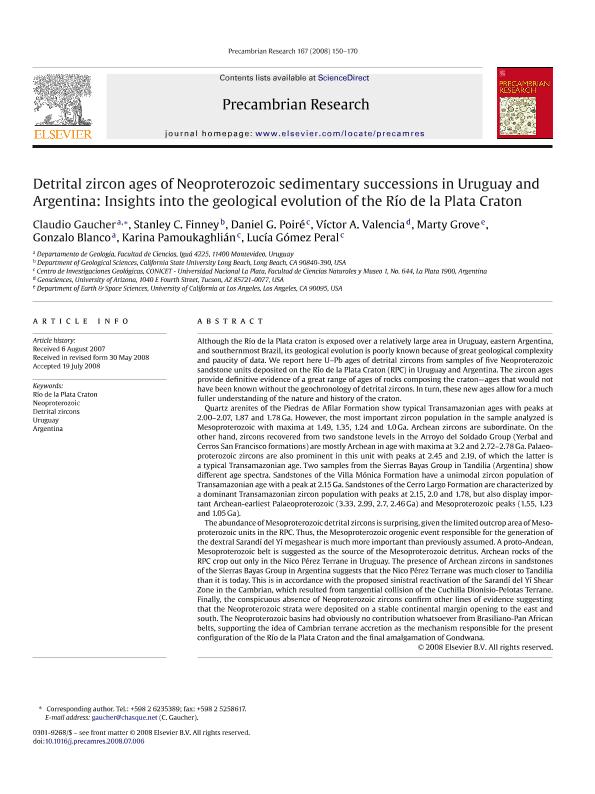Mostrar el registro sencillo del ítem
dc.contributor.author
Gaucher, Claudio
dc.contributor.author
Finney, Stanley C.
dc.contributor.author
Poire, Daniel Gustavo

dc.contributor.author
Valencia, Víctor A.
dc.contributor.author
Grove, Marty
dc.contributor.author
Blanco, Gonzalo
dc.contributor.author
Pamoukaghlian, Karina
dc.contributor.author
Gómez Peral, Lucia

dc.date.available
2019-04-12T22:00:33Z
dc.date.issued
2008-11
dc.identifier.citation
Gaucher, Claudio; Finney, Stanley C.; Poire, Daniel Gustavo; Valencia, Víctor A.; Grove, Marty; et al.; Detrital zircon ages of Neoproterozoic sedimentary successions in Uruguay and Argentina: Insights into the geological evolution of the Río de la Plata Craton; Elsevier Science; Precambrian Research; 167; 1-2; 11-2008; 150-170
dc.identifier.issn
0301-9268
dc.identifier.uri
http://hdl.handle.net/11336/74329
dc.description.abstract
Although the Río de la Plata craton is exposed over a relatively large area in Uruguay, eastern Argentina, and southernmost Brazil, its geological evolution is poorly known because of great geological complexity and paucity of data. We report here U-Pb ages of detrital zircons from samples of five Neoproterozoic sandstone units deposited on the Río de la Plata Craton (RPC) in Uruguay and Argentina. The zircon ages provide definitive evidence of a great range of ages of rocks composing the craton-ages that would not have been known without the geochronology of detrital zircons. In turn, these new ages allow for a much fuller understanding of the nature and history of the craton. Quartz arenites of the Piedras de Afilar Formation show typical Transamazonian ages with peaks at 2.00-2.07, 1.87 and 1.78 Ga. However, the most important zircon population in the sample analyzed is Mesoproterozoic with maxima at 1.49, 1.35, 1.24 and 1.0 Ga. Archean zircons are subordinate. On the other hand, zircons recovered from two sandstone levels in the Arroyo del Soldado Group (Yerbal and Cerros San Francisco formations) are mostly Archean in age with maxima at 3.2 and 2.72-2.78 Ga. Palaeoproterozoic zircons are also prominent in this unit with peaks at 2.45 and 2.19, of which the latter is a typical Transamazonian age. Two samples from the Sierras Bayas Group in Tandilia (Argentina) show different age spectra. Sandstones of the Villa Mónica Formation have a unimodal zircon population of Transamazonian age with a peak at 2.15 Ga. Sandstones of the Cerro Largo Formation are characterized by a dominant Transamazonian zircon population with peaks at 2.15, 2.0 and 1.78, but also display important Archean-earliest Palaeoproterozoic (3.33, 2.99, 2.7, 2.46 Ga) and Mesoproterozoic peaks (1.55, 1.23 and 1.05 Ga). The abundance of Mesoproterozoic detrital zircons is surprising, given the limited outcrop area of Mesoproterozoic units in the RPC. Thus, the Mesoproterozoic orogenic event responsible for the generation of the dextral Sarandí del Yí megashear is much more important than previously assumed. A proto-Andean, Mesoproterozoic belt is suggested as the source of the Mesoproterozoic detritus. Archean rocks of the RPC crop out only in the Nico Pérez Terrane in Uruguay. The presence of Archean zircons in sandstones of the Sierras Bayas Group in Argentina suggests that the Nico Pérez Terrane was much closer to Tandilia than it is today. This is in accordance with the proposed sinistral reactivation of the Sarandí del Yí Shear Zone in the Cambrian, which resulted from tangential collision of the Cuchilla Dionisio-Pelotas Terrane. Finally, the conspicuous absence of Neoproterozoic zircons confirm other lines of evidence suggesting that the Neoproterozoic strata were deposited on a stable continental margin opening to the east and south. The Neoproterozoic basins had obviously no contribution whatsoever from Brasiliano-Pan African belts, supporting the idea of Cambrian terrane accretion as the mechanism responsible for the present configuration of the Río de la Plata Craton and the final amalgamation of Gondwana. © 2008 Elsevier B.V.
dc.format
application/pdf
dc.language.iso
eng
dc.publisher
Elsevier Science

dc.rights
info:eu-repo/semantics/openAccess
dc.rights.uri
https://creativecommons.org/licenses/by-nc-sa/2.5/ar/
dc.subject
Argentina
dc.subject
Detrital Zircons
dc.subject
Neoproterozoic
dc.subject
RÍO de La Plata Craton
dc.subject
Uruguay
dc.subject.classification
Geología

dc.subject.classification
Ciencias de la Tierra y relacionadas con el Medio Ambiente

dc.subject.classification
CIENCIAS NATURALES Y EXACTAS

dc.title
Detrital zircon ages of Neoproterozoic sedimentary successions in Uruguay and Argentina: Insights into the geological evolution of the Río de la Plata Craton
dc.type
info:eu-repo/semantics/article
dc.type
info:ar-repo/semantics/artículo
dc.type
info:eu-repo/semantics/publishedVersion
dc.date.updated
2019-03-26T20:35:53Z
dc.journal.volume
167
dc.journal.number
1-2
dc.journal.pagination
150-170
dc.journal.pais
Países Bajos

dc.journal.ciudad
Amsterdam
dc.description.fil
Fil: Gaucher, Claudio. Departamento de Geología, Facultad de Ciencias, Iguá 4225, 11400 Montevideo; Uruguay
dc.description.fil
Fil: Finney, Stanley C.. Department of Geological Sciences, California State University Long Beach, Long Beach, CA 90840-390; Estados Unidos
dc.description.fil
Fil: Poire, Daniel Gustavo. Consejo Nacional de Investigaciones Científicas y Técnicas. Centro Científico Tecnológico Conicet - La Plata. Centro de Investigaciones Geológicas. Universidad Nacional de La Plata. Facultad de Ciencias Naturales y Museo. Centro de Investigaciones Geológicas; Argentina
dc.description.fil
Fil: Valencia, Víctor A.. Geosciences, University of Arizona, 1040 E Fourth Street, Tucson, AZ 85721-0077; Estados Unidos
dc.description.fil
Fil: Grove, Marty. Department of Earth & Space Sciences, University of California at Los Angeles, Los Angeles, CA 90095; Estados Unidos
dc.description.fil
Fil: Blanco, Gonzalo. Departamento de Geología, Facultad de Ciencias, Iguá 4225, 11400 Montevideo; Uruguay
dc.description.fil
Fil: Pamoukaghlian, Karina. Consejo Nacional de Investigaciones Científicas y Técnicas. Centro Científico Tecnológico Conicet - La Plata. Centro de Investigaciones Geológicas. Universidad Nacional de La Plata. Facultad de Ciencias Naturales y Museo. Centro de Investigaciones Geológicas; Argentina
dc.description.fil
Fil: Gómez Peral, Lucia. Consejo Nacional de Investigaciones Científicas y Técnicas. Centro Científico Tecnológico Conicet - La Plata. Centro de Investigaciones Geológicas. Universidad Nacional de La Plata. Facultad de Ciencias Naturales y Museo. Centro de Investigaciones Geológicas; Argentina
dc.journal.title
Precambrian Research

dc.relation.alternativeid
info:eu-repo/semantics/altIdentifier/doi/http://dx.doi.org/10.1016/j.precamres.2008.07.006
dc.relation.alternativeid
info:eu-repo/semantics/altIdentifier/url/https://www.sciencedirect.com/science/article/pii/S0301926808001678
Archivos asociados
